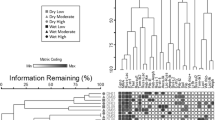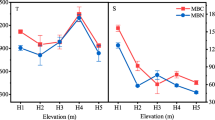Abstract
Rhizosphere communities are critical to plant and ecosystem function, yet our understanding of the role of disturbance in structuring these communities is limited. We tested the hypothesis that soil contamination with petroleum hydrocarbons (PHCs) alters spatial patterns of ecto- (ECM) and ericoid (ERM) mycorrhizal fungal and root-associated bacterial community structure in the shared rhizosphere of pine (Pinus contorta var. latifolia) and lingonberry (Vaccinium vitis-idaea) in reconstructed sub-boreal forest soils. Pine seeds and lingonberry cuttings were planted into containers with an organic (mor humus, FH or coarse woody debris, CWD) layer overlying sandy mineral horizons (Ae and Bf) of forest soils collected from field sites in central British Columbia, Canada. After 4 months, 219 mg cm-2 crude oil was applied to the soil surface of half of the systems; systems were sampled 1 or 16 weeks later. Composition, relative abundance and vertical distribution of pine ECMs were assessed using light microscopy; community profiles were generated using LH-PCR of ribosomal DNA. Multivariate analysis revealed that plant and soil factors were more important determinants of community composition than was crude oil treatment. Fungal communities differed between pine and lingonberry roots; ECM communities were structured by soil layer whereas ERM communities varied between FH and CWD soil systems. Bacterial communities varied between plants and soil layers, indicating properties of ECM and ERM rhizospheres and the soil environment influence bacterial niche differentiation. This integration of mycorrhizal and bacterial community analysis contributes to a greater understanding of forest soil sustainability in forest ecosystems potentially contaminated with PHCs.




Similar content being viewed by others
References
Agerer R (ed) (1987–2002) Colour atlas of ectomycorrhizae. Schwäbisch Gmünd, Germany: Einhorn-Verlag Eduard Dietenberger
Agerer R (2002) Exploration types of ectomycorrhizae: a proposal to classify ectomycorrhizal mycelial systems according to their patterns of differentiation and putative ecological importance. Mycorrhiza 11:107–114
Alexander M (2000) Aging, bioavailability, and overestimation of risk from environmental pollutants. Environ Sci Technol 34:4259–4265
Arocena JM, Sanborn P (1999) Mineralogy and genesis of selected soils and their implications for forest management in central and northeastern British Columbia. Can J Soil Sci 79:571–592
Baier R, Ingenhaag J, Blaschke H, Göttlein A, Agerer R (2006) Vertical distribution of an ectomycorrhizal community in upper soil horizons of a young Norway spruce (Picea abies [L.] Karst.) stand of the Bavarian Limestone Alps. Mycorrhiza 16:197–206
Balser TC, McMahon KD, Bart D, Bronson D, Coyle DR, Craig N, Flores-Mangual ML, Forshay K, Jones SE, Kent E, Shade AL (2006) Bridging the gap between micro - and macro-scale perspectives on the role of microbial communities in global change ecology. Plant Soil 289:59–70
Barrios E (2007) Soil biota, ecosystem services and land productivity. Ecol Econ 64:269–285
Bending GD, Read DJ (1997) Lignin and soluble phenolic degradation by ectomycorrhizal and ericoid mycorrhizal fungi. Mycol Res 101:1348–1354
Berch SM, Allen TR, Berbee ML (2002) Molecular detection, community structure and phylogeny of ericoid mycorrhizal fungi. Plant Soil 244:55–66
Burke RM, Cairney JWG (1998) Carbohydrate oxidases in ericoid and ectomycorrhizal fungi: a possible source of Fenton radicals during the degradation of ligninocellulose. New Phytol 139:637–645
Cairney JWG (2000) Evolution of mycorrhiza systems. Naturwissenschaften 87:467–475
Calvaruso C, Turpault M-P, Leclerc E, Frey-Klett P (2007) Impact of ectomycorrhizosphere on the functional diversity of soil bacterial and fungal communities from a forest stand in relation to nutrient mobilization processes. Microb Ecol 54:567–577
Dickie IA, Xu B, Koide RT (2002) Vertical niche differentiation of ectomycorrhizal hyphae in soil as shown by T-RFLP analysis. New Phytol 156:527–535
Dufrene M, Legendre P (1997) Species assemblages and indicator species: the need for a flexible asymmetrical approach. Ecol Monogr 67:345–366
Ettema CH, Wardle DA (2002) Spatial soil ecology. TREE 17:177–183
Fierer N, Schimel JP, Holden PA (2003) Variations in microbial community composition through two soil depth profiles. Soil Biol Biochem 35:167–176
Fritze H, Pietikäinen J, Pennanen T (2000) Distribution of microbial biomass and phospholipid fatty acids in Podzol profiles under coniferous forest. Eur J Soil Sci 51:565–573
Fujimura KE, Egger KN, Henry GHR (2008) The effect of experimental warming on the root-associated fungal community of Salix arctica. ISME 2:105–114
Genney DR, Anderson IA, Alexander IJ (2006) Fine-scale distribution of pine ectomycorrhizas and their extramatrical mycelium. New Phytol 170:381–390
Goodman DM, Durall DM, Trofymow JA, Berch SM (eds) (1996) A manual of concise descriptions of North American ectomycorrhizae. Mycologue Publications, Sidney
Horton TR, Bruns TD (2001) The molecular revolution in ectomycorrhizal ecology: peeking into the black box. Mol Ecol 10:1855–1871
Ingleby K, Mason PA, Last FT, Fleming LV (1990) Identification of ectomycorrhizae. Institute of Terrestrial Ecology, Natural Environment Research Council, Her Majesty’s Stationary Office, London Inst Terr Ecol Res Publ 5
Jones MD, Durall DM, Cairney JWG (2003) Ectomycorrhizal fungal communities in young forest stands regenerating after clearcut logging. New Phytol 157:399–422
Kalra YP, Maynard DG (1991) Methods manual for forest soil and plant analysis. Forestry Canada, Information Report NOR-X-319
Kuyper TW, Landeweert R (2002) Vertical niche differentiation by hyphae of ectomycorrhizal fungi in soil. New Phytol 156:323–325
LaMontagne MG, Schimel JP, Holden PA (2003) Comparison of subsurface and surface soil bacterial communities in California grassland as assessed by terminal restriction fragment length polymorphisms of PCR-Amplified 16S rRNA genes. Microb Ecol 46:216–227
Lilleskov EA, Fahey TJ, Horton TR, Lovett GM (2002) Belowground ectomycorrhizal fungal community change over a nitrogen deposition gradient in Alaska. Ecol 83:104–115
Lindahl BD, Ihrmark K, Boberg J, Trumbore SE, Högberg P, Stenlid J, Finlay RD (2007) Spatial separation of litter decomposition and mycorrhizal nitrogen uptake in a boreal forest. New Phytol 173:611–620
Mandyam K, Jumpponen A (2005) Seeking the elusive function of the root-colonising dark septate endophytic fungi. St Mycol 53:173–189
Martin KJ, Rygiewicz PT (2005) Fungal-specific PCR primers developed for the analysis of the ITS region of environmental DNA extracts. BMC Microbiol 5:28
McCune B, Grace JB (2002) Analysis of ecological communities. MjM software design, Gleneden Beach, Oregon, USA
McCune B, Mefford MJ (1999) PC-ORD version 5: multivariate analysis of ecological data. MjM software, Gleneden beach, Oregon, USA
Mills DK, Fitzgerald K, Litchfield CD, Gillevet PM (2003) A comparison of DNA profiling techniques for monitoring nutrient impact on microbial community composition during bioremediation of petroleum-contaminated soils. J Microbiol Meth 54:57–74
Molina R, Massicotte H, Trappe JM (1992) Specificity phenomena in mycorrhizal symbioses: community-ecological consequences and practical implications. In: Allen MF (ed) Mycorrhizal functioning: an integrative plant-fungal process. Chapman and Hall, New York, pp 357–423
Osborne CA, Rees GN, Bernstein Y, Janssen PH (2006) New threshold and confidence estimates for terminal restriction fragment length polymorphism analysis of complex bacterial communities. Appl Environ Microbiol 72:1270–1278
Perotto S, Girlanda M, Martino E (2002) Ericoid mycorrhizal fungi: some new perspectives on old acquaintances. Plant Soil 244:41–51
Ramette A, Tiedje JM (2007) Multiscale responses of microbial life to spatial distance and environmental heterogeneity in a patchy ecosystem. Proc Natl Acad Sci 104:2761–2766
Read DJ, Perez-Moreno J (2003) Mycorrhizas and nutrient cycling in ecosystems – a journey towards relevance? New Phytol 157:475–492
Robertson SJ, McGill WB, Massicotte HB, Rutherford PM (2007) Petroleum hydrocarbon contamination in boreal forest soils: a mycorrhizal ecosystems perspective. Biol Rev 82:213–240
Robertson SJ, Kennedy NM, Massicotte HB, Rutherford PM (2010) Enhanced biodegradation of petroleum hydrocarbons in the mycorrhizosphere of sub-boreal forest soils. Env Micro Rep 2:587–593
Rosling A, Landeweert R, Lindahl BD, Larsson K-H, Kuyper TW, Taylor AFS, Finlay RD (2003) Vertical distribution of ectomycorrhizal fungal taxa in a podzol soil profile. New Phytol 159:775–783
Rygiewicz PT, Anderson CP (1994) Mycorrhizae alter quality and quantity of carbon allocated below ground. Nature 369:58–60
Setälä H, Haimi J, Siira-Pietikäinen A (2000) Sensitivity of soil processes in northern forest soils: are management practices a threat? For Ecol Manag 133:5–11
Smith SE, Read DJ (2008) Mycorrhizal symbiosis, 3rd edn. Academic, London
Soil Classification Working Group (1998) The Canadian system of soil classification, 3 rd ed. Agric and Agri-Food Can Publ 1646(rev)
Tarradellas J, Bitton G (1997) Chemical pollutants in soil. In: Tarradellas J, Bitton G, Rossel D (eds) Soil ecotoxicology. Lewis Publishers, CRC Press Inc., New York, pp 3–32
Tedersoo L, Kőljalg U, Hallenberg N, Larsson K-H (2003) Fine scale distribution of ectomycorrhizal fungi and roots across substrate layers including coarse woody debris in a mixed forest. New Phytol 159:153–165
Trofimov SY, Rozanova MS (2003) Transformation of soil properties under the impact of oil pollution. Eurasian Soil Sci 36:S82–S87
Villarreal-Ruiz L, Anderson IC, Alexander IJ (2004) Interaction between an isolate from the Hymenoscyphus ericae aggregate and roots of Pinus and Vaccinium. New Phytol 164:183–192
Vrålstad T, Schumacher T, Taylor AFS (2002) Mycorrhizal synthesis between fungal strains of the Hymenoscyphus ericae aggregate and potential ectomycorrhizal and ericoid hosts. New Phytol 153:143–152
White TJ, Bruns T, Lee S, Taylor J (1990) Amplification and direct sequencing of fungal ribosomal RNA genes for phylogenetics. In: PCR protocols: a guide to methods and applications. Academic Press, Inc., pp 315–321
Xing B, McGill WB, Dudas MJ (1994) Cross-correlation of polarity curves to predict partition coefficients of nonionic organic contaminants. Environ Sci Technol 28:1929–1933
Acknowledgements
We thank Paul Sanborn for access to the field site, Steve Storch and John Orlowsky for greenhouse assistance, Anna Scarpino and Allen Esler for soil analyses, Mark Thompson for DNA analysis, Ralph Alm (Husky Oil, Prince George, BC), Dawn Stubley (Tree Seed Centre, Surrey, BC) and Barb Rayment (Birch Creek Nursery, Prince George, BC) for providing bioassay supplies. We are greateful to Keith Egger and Nabla Kennedy for help with molecular and multivariate analyses and to Linda Tackaberry, Julie Deslippe and Nina Koele for editorial comments. Funding for this project was provided by the Natural Sciences and Engineering Research Council of Canada to SJR, PMR, and HBM.
Author information
Authors and Affiliations
Corresponding author
Additional information
Responsible Editor: Harsh P. Bais.
Rights and permissions
About this article
Cite this article
Robertson, S.J., Rutherford, P.M. & Massicotte, H.B. Plant and soil properties determine microbial community structure of shared Pinus-Vaccinium rhizospheres in petroleum hydrocarbon contaminated forest soils. Plant Soil 346, 121–132 (2011). https://doi.org/10.1007/s11104-011-0802-2
Received:
Accepted:
Published:
Issue Date:
DOI: https://doi.org/10.1007/s11104-011-0802-2




